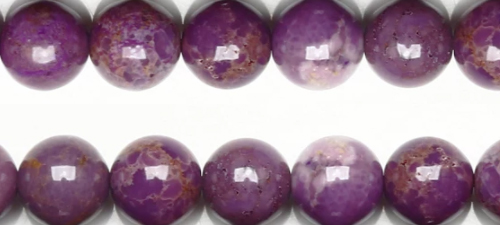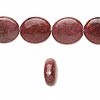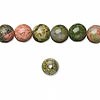
Agates are a member of the quartz family and are usually banded with stripes, showing beautiful patterns. Named after the River Achetes in Sicily, agates are thought to protect the wearer from danger and stimulate success.

Amazonite is a pale to mid soft blue-green stone. If you turn it, you sometimes see white glints Derivation From the Amazon (in South America)

Amber is the name for fossil resin or tree sap that is appreciated for its colour. It is used for the manufacture of ornamental objects and jewellery. Although not minarelized, it is sometimes considered a gemstone. Most of the world’s amber is in the range of 30–90 million years old.

Amethyst ranges from lavender, lilac to mauve and purple in colour, it is the most valuable of the quartz group. The Romans believed induced a sober mind, the name is derived from the Greek Amethystos, which means ‘against drunkenness’. It is believed to bring stability, peace and strength and is also believed to aid sleeplessness. Amethyst is the birthstone for February, symbolising Sincerity. Like many of our semi precious stones, our Amethyst may have natural inclusions and variable colours, swirls of white or grey and ranging from light lilac to dark purple; this is often an indicator of the quality of the stone – the clearer the stone, the darker the colour, the more valuable, and as with most things, a wide variety is available; Amethyst is rarely dyed, but can sometimes be heat treated, an accepted and ancient practice in lapidary and one that ensures the stone is available in the quantities demanded; this does not affect the quality of the stone.

Angelite is a soft stone with a soft blue color. The stone is found in Peru and called Angelite for it has the color of heaven. A stone for good fortune, health and blessings

Aquamarine colours range from blue, blue/green, almost transparent to greenish hues, the seawater colour of this stone gave the gemstone its name. It is said to enhance clarity of mind and aid creative self-expression. In medieval times the stone was thought to awaken the love of married couples and is known as the ‘sailors gem’ ensuring safe passage across stormy seas. It is one of the birthstones for March

Aragonite can be found in a variety of colours ranging from burnt orange to white, but our favourite is the sunshine yellow, examples of which can be found below. Deposits of this stone can be found in various places but the initial discovery was in the Rio Aragon region of Spain where it was discovered in 1788, hence the name, and it is said to be associated with the Capricorn astrological sign; Aragonite is related to Calcite, for which it can sometimes be mistaken, and these minerals are present in shells and pearls.

Aventurine is a soft green semi-translucent to mostly opaque stone with mica flecks. Aventurine also comes in silvery, yellow, reddish brown, greenish-brown, bluish green and orange. It contains inclusions of small crystals that reflect light and give a range of colors – depending on the nature of the inclusion.

Azurite is a very popular mineral because of its unparalleled color, a deep blue called “azure”, hence its name. Azure is derived from the arabic word for blue. The color is due to the presence of copper . Azurite has been used as a dye for paints and fabrics for eons. Unfortunately, at times its color is too deep and larger crystals can appear black. Small crystals and crusts show the lighter azure color well. Azurite is often associated with its colorful close cousin, Malachite

Citrine is a quartz, its colours range from yellow/gold to gold/brown to amber and can have white to grey inclusions in it – some citrine is very light and some is dark, its name derives from its colour, ‘citron’ being French for lemon. Citrine is thought to dispel fear and to stimulate mental focus and endurance.

Carnelian nourishes and vitalises your entire being, bestowing optimism and enthusiasm for life. The orange ray carried by Carnelian deeply relaxes your mind, emotions, and physical cells so they can release their disharmony and disease. Carnelian enhances positive emotions, promoting a brighter outlook and appreciation for life. Carnelian is used as a sleep aid for its ability to calm and ease anxiety. In Western society, Astrologers name this stone as a primary birthstone of Virgo (Aug. 22nd to Sept. 22nd).

Coral is the vacated home of a marine animal and grows in branchlike formations, it is most frequently red, but also can be found in pink, white, black and blue. The black variety is especially protected as it is endangered and should not be purchased. American Indians regarded Coral as a symbol of vitality. It is said to bring inner peace, intuition and imagination; Coral is very hard to find these days and most Coral these days is dyed which is an accepted gemstone practice – there is some interesting stuff around including sponge Coral and varying colours, but it is increasingly difficult to source.

Fluorite is a beautiful and versatile stone which ranges from greens to lilacs, clear and purples, this range makes this stone very special and it occurs in varying grades from clear/translucent to slightly cloudy to cloudy in a range of colours including purple, lilac, clear, a range of greens and some yellow colours (see below) more rarely – the stones usually have inclusions of white to black within them, inner flaws which are part and parcel of the stone being a natural occurrence giving the stone its interest

Garnets are often used to symbolise love and devotion and is traditionally known as the ‘stone of commitment’, the name Garnet comes from the Latin for pomegranate which has bright red, Garnet-like seeds. In medieval times Garnets were thought to cure depression and protect against bad dreams. It is the birthstone for January, symbolising Constancy.

Hematite/Hematine is an iron ore, and is a sleek dark grey/black colour, the colour of polished coal; the stone is said to promote a calming influence, it is often used with pearls or mother of pearl – we have matching sized mother of pearl beads for the rice shaped beads, and this is an excellent semi precious stone to use as a spacer bead as it is unobtrusive and seems to make other stones and components stand out.

Jade; Jadeite There are two distinct mineral forms of Jade; Jadeite which is white/yellow to pale green (this looks good with other pastels, perhaps Smoky Quartz) or sometimes a combination of the two and can be bright green (imperial Jade) or even blue/grey, lavender or pink or green with black inclusions and even brown to cognac colouring, or nephrite which is more common, which is usually green. Jadeite is the slightly harder of the two forms Jade is believed to be a soft, gentle stone and to promote a long and prosperous life and is the stone of friendship; with the current trend for the colour green, we are seeing a lot more interest in this pretty stone in all its forms, but we really like this stone because it offers so many interesting and varied colours

Jasper is a quartz in the Chalcedony family, which includes Tigerseye, Agate, Bloodstone and Carnelian, Chrysoprase and SardOnyx; Jasper is usually striped, spotted or multi-coloured and is rarely one colour – here we have our collection of our own Jasper.

Laboradite has an uninteresting background colour of dark grey but displays a beautiful iridescence giving off rainbow-coloured reflections known as labradorescence when light hits it in certain directions – this is quite stunning and it is one of those stones that initially can appear a bit uninteresting until it is turned this way or that, and then the colours can be magical. It is thought by some to symbolise the moon and the sun and in fact has been found to be an ingredient of moon rock. It is said to assist the wearer to handle changes, promoting strength and perseverance.

Lapis Lazuli is prized for its intense blue colouring (the deeper the better), it often comes from Afghanistan. For centuries powdered lapis was used as an ingredient in paint to create a very special blue, but the pigment now used in paint is man made as Lapis is far too expensive a component for such an application these days. Its name derives from medieval Latin and means ‘blue stone’. It is said to promote friendship and goodwill and to guard the wearer against evil. It is one of the birthstones for December (along with Turquoise) and symbolises Prosperity.

Lepidolite is a soft stone with a soft violet color and various shades of purple, violet or yellow. It has a shimmer inside which gives it a beautiful shine ad spark.
Lepidolite is the perfect healing crystal to help a woman stabilize her emotions, dissolve the pain of deeply felt wounds, soothe the heart, and reduce stress and depression.

Iolite The name comes from the Greek ios, which means violet. Iolite is usually a purplish blue, with a softness to the colour. Some people call Iolite “water sapphire”.

Malachite is a striking and sophisticated green colour, varying from bright to dark greens with stripes of darker or lighter greens or black throughout – it looks very good with black Onyx and silver. It is thought to stimulate instinctive and intuitive reasoning and to represent fidelity in love and friendship, loyalty in partnerships as well as practicality and responsibility in business relationships.

Mookite Beads – a type of Jasper, a very colourful stone with cream, yellow, butterscotch, pink, red, burgundy and chocolate (amongst others) – fabolous range of shades in between which gives this stone a great deal of versatility – from Western Australia about 600 miles north of Perth; this stone is also found in China.

Moonstones come in a variety of colors, ranging from colorless to white, gray, brown, yellow, orange, green, or pink. Clarity ranges from transparent to translucent.
Moonstone shows a silvery or bluish iridescence, that is caused by the intergrowth of two different types of feldspar with different fractive indexes.

Ranging in a range of shades from olive green, bottle green to yellowish green, Peridot is the name given to gem quality specimens of the mineral Olivine. , it is believed to reduce stress, open new doors of opportunity and stimulate the mind. In the Middle Ages, Peridot was believed to dispel the darkness and guard against terrors of the night. Peridot is one of the birthstones for August, symbolising married happiness.

Prehnite

Onyx is a translucent Chalcedony, part of the Quartz family, and for hundreds of years was carved to produce cameos – we have a range from black to black and white banded. SardOnyx is known as the stone of marital happiness.

Rhodochrosite (meaning rose-coloured) is a most attractive mineral;the name is derived from the Greek word “rhodon” (pink) and “chros” (colour). It was referred to as the Inca Rose by the Incas who believed the blood of their rulers turned into this stone. Rhodochrosite is known as a stone of love and balance.

Rhodonite is an attractive mineral which is named after the Greek word for rose, rhodon. Its beautiful rose-pink colour is sometimes confused with Rhodochrosite, but it is a distinct mineral in its own right.

Rose Quartz A delicate soft pink in colour, though can range from off-white pink to warm rose-pink, it is mostly produced in Namibia and South Africa. The early Chinese used Smoky Quartz for carvings of the goddess of Peace as the colour was thought to reflect her gentleness and wisdom. It is said to promote a restful, cooling energy that will restore calmness, balance and clarity to the emotions and is considered excellent for healing emotional ‘wounds’.

Smoky Quartz is formed as a result of natural irradiation and often has a large constituent of Sodium; the stone can sometimes be enhanced by heat treatment – generally speaking when the stone is very dark it is usually safe to assume it has been heat enhanced to give a deeper colour – Sources include Brazil, Switzerland, the Himalayas, and Mexico. The stone sometimes has sufficient inclusions to give it a further name – milky quartz; quartz is one of the most frequently found minerals on the earth and comes in many varieties including Amethyst, Rutilated Quartz, Smoky Quartz and Citrine to name a few – the Smoky variety has a lovely range of smoke colours which range from pale to dark

Sodalite is named in reference to its sodium content and is opaque dark blue laced with white striates of calcite. The color of blue is very typical and is one of the constituents of Lapis Lazuli; it is believed to be a soothing and calming stone and is thought to stimulate courage

Tiger Eye is mined in South Africa, and is said to eliminate the ‘blues’ and to bring brightness and to bring brightness and optimism to the user. It has been used in the treatment of asthma, disorders of the eye, the throat and the reproductive system.

Tourmaline comes in a huge range of colours including pink (rubellite), blue (indicolite), colourless (achroite) and green. It is thought to be tranquil and calming and is one of the birthstones for October, signifying hope.

Turquoise is soft and porous when mined. To make it suitable for jewelry use, it is permeated with a clear resin. This ‘stabilization’ process hardens the Turquoise, darkens its color, and makes it resistant to common chemicals such as swimming pool chlorine. With this process, Turquoise can be hardened enough to be carved into unique shapes.
It was first mined over 6000 years ago, and Native American Indians have used it as a protective stone and used it to bring rain (no need of that here in the UK then). The stone is believed to enhance creative expression, peace of mind, communication, friendship and loyalty. Turquoise is one of the birthstones of December, along with Lapis Lazuli, and symbolises Prosperity.

Rutile is one of the three forms of Titanium Dioxide found in nature. The other two are Brookite and Anatase.
Sellaite (Magnesium Fluoride) has a similar crystal structure to the Rutile group.

Unakite First discovered in the United States the Unakas Mountains of North Carolina, Unakite is an altered granite composed of pink orthoclase feldspar, green epidote, and generally clear quartz It exists in various shades of green and pink and is usually mottled in appearance. In good quality unakite is considered a semi precious stone